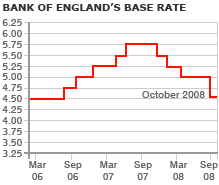 Welcome...kkk. to Buyabetterhome fgdfhgdfgdfgdfgdfgdf
Welcome...kkk. to Buyabetterhome fgdfhgdfgdfgdfgdfgdf 
Unless you’ve been living on the planet Mars for the past few weeks you will have realized that the Bank of England has made massive cuts in the base rate of interest in a desperate attempt to help stave off the predicted recession. Half a percent in October followed by a shock one and half percent in November has brought it down to just 3% - the lowest figure since the 1950s. So as homeowners, we should all be expecting big cuts in our monthly mortgage bills, shouldn’t we? Well the reality is that mortgage lenders did their best to delay the inevitable but after government pressure they have finally caved in with most lenders passing on the rate cut in full.
If you are one of around four million homeowners on an existing tracker mortgage you would have known immediately that you would be benefitting from the rate cut, but 800,000 borrowers on lenders’ standard variable rates had a little longer to wait. The day after the Bank of England’s announcement Lloyds TSB, Cheltenham & Gloucester, Bradford & Bingley, Abbey and Nationwide announced that they would be cutting their standard variable rate by the full 1.5%. The reality of this cut means that borrowers will be saving around £120 per month on a £150,000 capital repayment loan and £187.50 on an interest- only mortgage.
What the banks did do very quickly, however, was to cause anger in a public that has just bailed them out to the tune of £37bn by pulling the plug on nearly all tracker products – culprits included major players such as Halifax, Nationwide, Abbey, Woolwich and Lloyds TSB. The withdrawal of almost every product that pegs the Bank of England base rate had happened before end of play on the same day of the rate cut announcement, preventing any additional borrowers from taking advantage of it. The unfortunate reality is that it is a domino effect – once one or two banks pulled their tracker products the rest follow suit to avoid being swamped. Yvette Cooper, Chief Secretary to the Treasury summed up the way many people were feeling when she stated: “The government has stepped in to make the banking system safe, to support the banks. It is right that the banks do their bit to support everybody else.”
The majority of borrowers (around 58%) are on a fixed rate so they will not be getting the early Christmas present that other borrowers are about to experience. There may yet be a sting in the tail for homeowners on tracker mortgages who are currently enjoying a honeymoon period. Some analysts believe that the base rate will drop again – maybe even getting as low as 1% some time next year. Tracker customers may be somewhat upset to learn that clever bankers have insured themselves against such an eventuality by introducing so-called “collars” into the small print. Basically what this means is that when interest rates fall below a certain threshold – the banks are no longer obligated to pass on the saving. For example the Nationwide collar is triggered at 2.75% and many other banks have a collar set at 3% - including Halifax. HSBC have insured themselves against rate cuts even further with small-print terms that give them the right to stop cutting tracker rates if “there is a material change in the market”.
